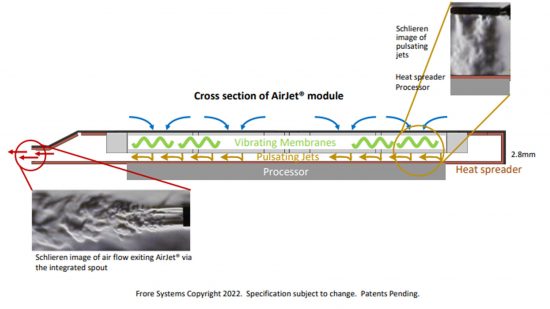The Frore Systems AirJet is one of the most exciting technologies we’ve seen in some time. It’s a new fan technology that uses piezoelectric oscillation to move astonishing amounts of air using the tiniest of components.
Although in development for some time, the technology has been demonstrated to full effect, and even been announced as available in some products such as a mini PC from Zotac, at the recent Computex 2023 trade show in Taiwan.
The technology uses the piezoelectric effect whereby a current applied to a piezoelectric crystal causes it to oscillate – just as has been used in watches for decades. Except here the effect is much greater and the vibration is harnessed to move air.
Frore Systems has developed the technology sufficiently that it can claim its current-generation product to be solid state – i.e. formed from a single solid substance – as it builds up the layers of its piezoelectric fan using similar lithography to how CPU and GPU chips are made.

The oscillating chip technology is tiny but operates at such speeds that it can shift significant amounts of air through tiny openings. By combining many such jets, the AirJet products can generate serious amounts of overall airflow, and at high back pressures too. The latter means the system can rely on tiny paper dust filters to keep the system clean without significantly impacting airflow.
Currently available in two configurations, the AirJet Mini can shift 5.25W of heat at an impressively quiet 21dBA noise level, while only consuming a maximum of 1 Watt of power. Those figures a roughly similar to typical laptop coolers that use one or two Watts to dissipate 10-20W. However, the AirJet Mini dimensions of 27.5 x 41.5 x 2.8 mm are far smaller than those coolers so there’s room for two or three AirJet Minis in the space of a single conventional cooler.
As well as allowing for more powerful or compact cooling solutions in conventional laptops, the Air Jet Mini is also small enough it could fit in otherwise very space-constrained ultra-portable fanless laptops. These machines are typically limited to around 10W CPU power but Frore Systems claims it could double the CPU peak wattage to 20W for huge leaps in peak performance without toasting users’ laps.

Meanwhile, the AirJet Pro is a larger 31.5 x 71.5 x 2.8 mm unit that can dissipate 10.5W while consuming 1.7W. It could also see applications in laptops and mini PCs amongst many other devices.

As for the impact of AirJets on desktop PC cooling, it’s unlikely to replace the best PC fans for overall case cooling or the larger fans on CPU and GPU coolers. However, we could see it used as part of the overall cooling solution in larger graphics cards (it would be ideal for blasting hot air out the PCIe slot), on exotic new CPU coolers, or perhaps most likely as cooling for components closer to the motherboard, such as VRMs or M.2 SSDs. We certainly can’t wait to see what manufacturers come up with.
Are you as excited as us to see what AirJet cooling can do with the PC industry? Let us know your thoughts on the Custom PC Facebook page, via Twitter, or join our Custom PC and Gaming Setup Facebook group and tap into the knowledge of our 390,000+ members.
